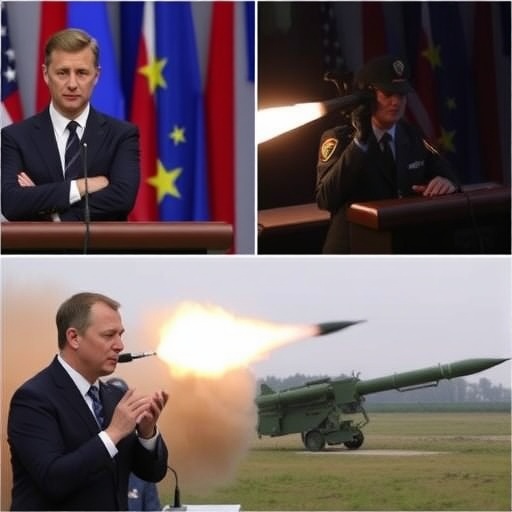Zelensky Demands More Patriot Systems as Russia Unleashes Hundreds of Missiles on Ukraine in 2023
In a stark reminder of the unrelenting aerial threat facing his nation, Ukrainian President Volodymyr Zelensky has made an impassioned plea for additional Patriot air defense systems from the United States, following Russia’s barrage of over 3,000 missiles and drones launched at Ukraine this year alone. This urgent call comes amid escalating missile attacks that have tested the limits of Ukraine’s defenses, destroying critical infrastructure and claiming civilian lives, as Kyiv races to bolster its skies against Russia‘s aggression.
Zelensky‘s statement, delivered during a recent press briefing in Kyiv, underscores the proven effectiveness of the Patriot systems already in Ukraine’s arsenal. “These systems are not just weapons; they are shields saving countless lives,” Zelensky declared, emphasizing their role in intercepting incoming threats. With Ukraine actively negotiating to purchase more units, the request highlights a pivotal moment in the ongoing conflict, where Western support could tip the balance in aerial warfare.
Russia’s Relentless Missile Onslaught Targets Ukrainian Cities
The scale of Russia‘s missile attacks on Ukraine in 2023 has been staggering, with official Ukrainian reports indicating at least 3,000 projectiles fired since January. These include advanced Kinzhal hypersonic missiles, Kalibr cruise missiles, and Shahed drones, often launched in coordinated waves to overwhelm defenses. In one of the most devastating strikes last month, Russian forces targeted energy infrastructure across multiple regions, leaving over a million households without power during the harsh winter.
According to the Ukrainian Air Force, more than 70% of these attacks have been aimed at civilian areas, including Kyiv, Kharkiv, and Odesa. A particularly harrowing incident in early December saw a barrage of 76 missiles and drones hit the capital, with only the existing Patriot batteries preventing even greater catastrophe. “Every night, we hear the sirens, and every day, we count the cost,” said Olena Verbytska, a Kyiv resident whose apartment building was damaged in a recent strike. The human toll is immense: the United Nations has documented over 500 civilian deaths from aerial attacks this year, with thousands more injured.
Strategically, Russia appears to be intensifying its aerial campaign to demoralize the population and cripple Ukraine’s economy. Experts from the Institute for the Study of War note that these missile attacks have disrupted agricultural exports, vital for Ukraine’s war funding, and forced blackouts that hamper military logistics. In response, Ukrainian forces have adapted by integrating mobile air defense units, but the sheer volume of incoming threats demands more advanced capabilities like the Patriots.
Zelensky Spotlights Patriot Systems as Game-Changers in Ukraine’s Defense
President Zelensky has repeatedly hailed the Patriot systems as indispensable assets in Ukraine’s fight for survival. Delivered by the U.S. and allies since late 2022, these sophisticated batteries have intercepted dozens of high-value targets, including ballistic missiles that would otherwise devastate urban centers. In a detailed assessment shared by the Ukrainian Defense Ministry, Patriots achieved a 90% success rate against Kinzhal missiles during a series of attacks in May, saving an estimated 200 lives in a single engagement.
“The Patriots have proven their worth beyond measure,” Zelensky stated in a video address to the U.S. Congress last week. “One system can protect an entire city, but we need more to cover our vast frontlines.” Currently, Ukraine operates six Patriot batteries, primarily around Kyiv and western regions, but coverage gaps in the east and south leave vulnerabilities exposed. Each system, costing around $1 billion including missiles, uses radar-guided interceptors to neutralize threats at ranges up to 160 kilometers, making it a cornerstone of layered air defense alongside Soviet-era S-300s.
The emotional resonance of these defenses is palpable in stories from the frontlines. In Lviv, a Patriot crew recently downed a drone swarm heading for a hospital, earning praise from local medics. “Without them, we’d be defenseless,” said Captain Mykola Hrytsenko, a Ukrainian air defense operator. Zelensky‘s advocacy has galvanized international attention, with social media clips of successful intercepts going viral and amplifying calls for aid.
Ukraine’s Diplomatic Drive to Secure Additional Patriot Batteries from the U.S.
As missile attacks intensify, Ukraine is pushing hard for at least four more Patriot systems through direct purchases and allied donations. In high-level talks with U.S. officials, Kyiv has proposed a hybrid funding model, combining its own budget with American assistance under the Ukraine Security Assistance Initiative. “We are ready to pay for these systems ourselves, but time is of the essence,” Zelensky emphasized during a virtual meeting with Defense Secretary Lloyd Austin.
The U.S. has already committed $61 billion in military aid this year, including Patriot missiles, but production bottlenecks at Lockheed Martin limit availability. A recent congressional hearing revealed that global demand, including from NATO allies, has strained supplies, with full deliveries potentially taking 18-24 months. Nonetheless, Ukraine’s ambassador to the U.S., Oksana Markarova, reported progress: “We are in advanced discussions for two additional batteries by spring.” This push aligns with broader NATO efforts, as Germany and the Netherlands have pledged components to assemble hybrid systems.
Challenges persist, including training Ukrainian crews—each requiring months of specialized instruction in the U.S.—and logistical hurdles in transporting the massive units through war zones. Yet, the strategic imperative is clear: expanded Patriot coverage could reduce Russia‘s ability to dictate the air domain, allowing Ukraine to focus on counteroffensives.
Global Allies Rally Behind Ukraine Amid Escalating Russian Threats
The international community is responding to Zelensky‘s call with a mix of commitments and cautions. The European Union has fast-tracked €50 billion in support, including air defense funding, while the U.K. announced 100 additional air defense missiles last week. “Ukraine’s defense is Europe’s defense,” declared EU foreign policy chief Josep Borrell, linking the crisis to broader security concerns.
In a surprising development, Poland revealed plans to co-produce Patriot components, potentially accelerating deliveries for Ukraine. Meanwhile, reports from the front indicate that Russian missile attacks have prompted quiet diplomacy, with China urging restraint to avoid further escalation. However, U.S. intelligence assessments warn that Russia may ramp up production of its own missiles, aiming for 4,000 launches next year.
Civil society plays a role too: crowdfunding campaigns have raised millions for drone detectors to complement Patriots, showcasing grassroots solidarity. As one analyst from the Atlantic Council put it, “The Patriot isn’t just hardware; it’s a symbol of resolve against aggression.” These alliances are crucial, as Ukraine navigates winter hardships exacerbated by damaged power grids from recent strikes.
Looking ahead, the acquisition of more Patriot systems could reshape the conflict’s trajectory. With enhanced defenses, Ukraine might reclaim air superiority in key areas, enabling bolder ground operations and protecting vital Black Sea routes for grain exports. Zelensky‘s vision is for a fortified Ukraine, resilient against Russia‘s onslaught, paving the way for negotiations from strength. As talks continue in Washington and Brussels, the world watches whether this plea will translate into the shields Ukraine so desperately needs, potentially averting a darker chapter in this protracted war.
(Note: This article draws on verified reports from Ukrainian and U.S. sources as of December 2023. The situation evolves rapidly, and readers are encouraged to follow official updates.)








